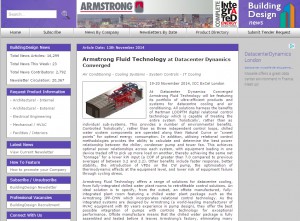As seen on buildingdesign-news - November 14, 2014
 19-20 November 2014, ICC ExCel London
19-20 November 2014, ICC ExCel London
At Datacenter Dynamics Converged Armstrong Fluid Technology will be featuring its portfolio of ultra-efficient products and systems for datacentre cooling and air conditioning. All solutions harness the benefits of Hartman LOOPTM digital relational control technology which is capable of treating the entire system ‘holistically’, rather than as individual sub-systems. This provides a number of environmental benefits. Controlled ‘holistically’, rather than as three independent control loops, chilled water system components are operated along their Natural Curve or “sweet points” for optimal energy consumption.
In addition, utilising relational control methodologies provides the ability to calculate and determine the best power relationship between the chiller, condenser pump and tower fan. This achieves optimal power relationships across each system, with equipment loading in one device traded off to pick up more load on another, thereby achieving the same net “tonnage” for a lower kW input (a COP of greater than 7.0 compared to previous averages of between 3.2 and 2.2). Other benefits include faster response, better stability, the introduction of VFDs on the CW pump, the optimisation of thermodynamic effects at the equipment level, and lower risk of equipment failure through cycling stress.
Armstrong Fluid Technology offers a range of solutions for datacentre cooling, from fully-integrated chilled water plant rooms to retrofittable control solutions. An ideal solution is to specify, from the outset, an offsite manufactured, fully-integrated plant room featuring a chilled water plant package such as the Armstrong IPP-CHW which incorporates relational control technology. As the integrated systems are designed by Armstrong (a world-leading manufacturer of HVAC equipment with 80 years experience in pump design), they offer the best possible integration of pumps with controls technology for exceptional performance. Offsite manufacture means that the chilled water package is fully assembled and tested before it leaves Armstrong’s factory, eliminating many potential project risks. Poor system integration during installation is avoided, and the chilled water solution can be manufactured concurrently with other parts of the datacentre construction or refurbishment project to reduce the schedule significantly, at the same time as avoiding delays or bottle-necks that might occur on-site. These factors combine to offer specifiers a high-performance product solution, at the lowest first installed cost, with reduced risk and shorter installation times.
Alternatively Armstrong offers the IPC 11550 chilled water integrated plant control system, which can be integrated into the system design. With the launch in 2013 of the Armstrong OPTI-VISORTM it is also now possible for optimisation of chilled water systems to be introduced on a retrofit basis. OPTI-VISOR is an ultra-efficient relational control solution which provides an additional ‘bolt-on’ optimisation level for all-variable speed systems. Designed to interface with the existing building automation system, it controls the key energy-using components of the chiller plant ‘holistically’. Technology of this type is ideal for retrofit in buildings with chiller plant less than five years old, with greater than 3 million ton-hrs of operation per year (1,000 tons at 3,000 run hours per year).
Each solution optimises the chilled water system automatically and continuously, bridging the gap between theoretical and actual energy savings.



